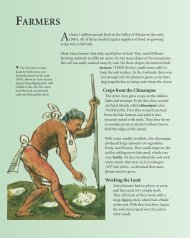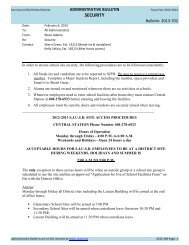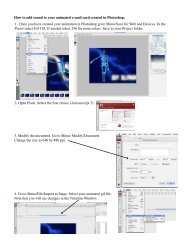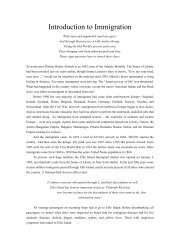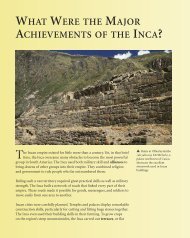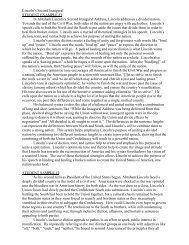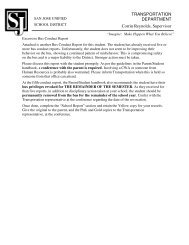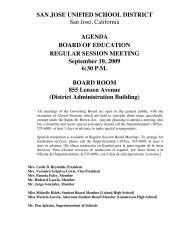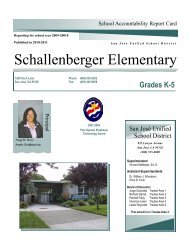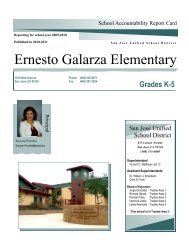Grade Two - SJUSD
Grade Two - SJUSD
Grade Two - SJUSD
Create successful ePaper yourself
Turn your PDF publications into a flip-book with our unique Google optimized e-Paper software.
Mathematics Content Standards for CA Public Schools<br />
<strong>Grade</strong> <strong>Two</strong><br />
Mathematics Content Standards<br />
Adopted by the California State Board of Education<br />
December 1997<br />
Page 10 of 57<br />
By the end of grade two, students understand place value and number relationships in addition<br />
and subtraction, and they use simple concepts of multiplication. They measure quantities with<br />
appropriate units. They classify shapes and see relationships among them by paying attention to<br />
their geometric attributes. They collect and analyze data and verify the answers.<br />
Number Sense<br />
1.0 Students understand the relationship between numbers, quantities, and place value in<br />
whole numbers up to 1,000:<br />
1.1 Count, read, and write whole numbers to 1,000 and identify the place value<br />
for each digit.<br />
1.2 Use words, models, and expanded forms (e.g., 45 = 4 tens + 5) to represent<br />
numbers (to 1,000).<br />
1.3 Order and compare whole numbers to 1,000 by using the symbols .<br />
2.0 Students estimate, calculate, and solve problems involving addition and subtraction of<br />
two-and three-digit numbers:<br />
2.1 Understand and use the inverse relationship between addition and<br />
subtraction (e.g., an opposite number sentence for 8 + 6 = 14 is 14 - 6 = 8) to<br />
solve problems and check solutions.<br />
2.2 Find the sum or difference of two whole numbers up to three digits long.<br />
2.3 Use mental arithmetic to find the sum or difference of two two-digit numbers.<br />
3.0 Students model and solve simple problems involving multiplication and division:<br />
3.1 Use repeated addition, arrays, and counting by multiples to do multiplication.<br />
3.2 Use repeated subtraction, equal sharing, and forming equal groups with<br />
remainders to do division.<br />
3.3 Know the multiplication tables of 2s, 5s, and 10s (to "times 10") and commit<br />
them to memory.<br />
4.0 Students understand that fractions and decimals may refer to parts of a set and parts<br />
of a whole:<br />
4.1 Recognize, name, and compare unit fractions from 1/12 to 1/2.<br />
4.2 Recognize fractions of a whole and parts of a group (e.g., one-fourth of a pie,<br />
two-thirds of 15 balls).
Mathematics Content Standards for CA Public Schools<br />
4.3 Know that when all fractional parts are included, such as four-fourths, the<br />
result is equal to the whole and to one.<br />
Adopted by the California State Board of Education<br />
December 1997<br />
Page 11 of 57<br />
5.0 Students model and solve problems by representing, adding, and subtracting amounts<br />
of money:<br />
5.1 Solve problems using combinations of coins and bills.<br />
5.2 Know and use the decimal notation and the dollar and cent symbols for<br />
money.<br />
6.0 Students use estimation strategies in computation and problem solving that involve<br />
numbers that use the ones, tens, hundreds, and thousands places:<br />
6.1 Recognize when an estimate is reasonable in measurements (e.g., closest<br />
inch).<br />
Algebra and Functions<br />
1.0 Students model, represent, and interpret number relationships to create and solve<br />
problems involving addition and subtraction:<br />
1.1 Use the commutative and associative rules to simplify mental calculations<br />
and to check results.<br />
1.2 Relate problem situations to number sentences involving addition and<br />
subtraction.<br />
1.3 Solve addition and subtraction problems by using data from simple charts,<br />
picture graphs, and number sentences.<br />
Measurement and Geometry<br />
1.0 Students understand that measurement is accomplished by identifying a unit of<br />
measure, iterating (repeating) that unit, and comparing it to the item to be measured:<br />
1.1 Measure the length of objects by iterating (repeating) a nonstandard or<br />
standard unit.<br />
1.2 Use different units to measure the same object and predict whether the<br />
measure will be greater or smaller when a different unit is used.<br />
1.3 Measure the length of an object to the nearest inch and/ or centimeter.<br />
1.4 Tell time to the nearest quarter hour and know relationships of time (e.g.,<br />
minutes in an hour, days in a month, weeks in a year).<br />
1.5 Determine the duration of intervals of time in hours (e.g., 11:00 a.m. to 4:00<br />
p.m.).<br />
2.0 Students identify and describe the attributes of common figures in the plane and of<br />
common objects in space:
Mathematics Content Standards for CA Public Schools<br />
2.1 Describe and classify plane and solid geometric shapes (e.g., circle, triangle,<br />
square, rectangle, sphere, pyramid, cube, rectangular prism) according to the<br />
number and shape of faces, edges, and vertices.<br />
2.2 Put shapes together and take them apart to form other shapes (e.g., two<br />
congruent right triangles can be arranged to form a rectangle).<br />
Statistics, Data Analysis, and Probability<br />
Adopted by the California State Board of Education<br />
December 1997<br />
Page 12 of 57<br />
1.0 Students collect numerical data and record, organize, display, and interpret the data on<br />
bar graphs and other representations:<br />
1.1 Record numerical data in systematic ways, keeping track of what has been<br />
counted.<br />
1.2 Represent the same data set in more than one way (e.g., bar graphs and<br />
charts with tallies).<br />
1.3 Identify features of data sets (range and mode).<br />
1.4 Ask and answer simple questions related to data representations.<br />
2.0 Students demonstrate an understanding of patterns and how patterns grow and<br />
describe them in general ways:<br />
2.1 Recognize, describe, and extend patterns and determine a next term in linear<br />
patterns (e.g., 4, 8, 12 ...; the number of ears on one horse, two horses, three<br />
horses, four horses).<br />
2.2 Solve problems involving simple number patterns.<br />
Mathematical Reasoning<br />
1.0 Students make decisions about how to set up a problem:<br />
1.1 Determine the approach, materials, and strategies to be used.<br />
1.2 Use tools, such as manipulatives or sketches, to model problems.<br />
2.0 Students solve problems and justify their reasoning:<br />
2.1 Defend the reasoning used and justify the procedures selected.<br />
2.2 Make precise calculations and check the validity of the results in the context<br />
of the problem.<br />
3.0 Students note connections between one problem and another.



